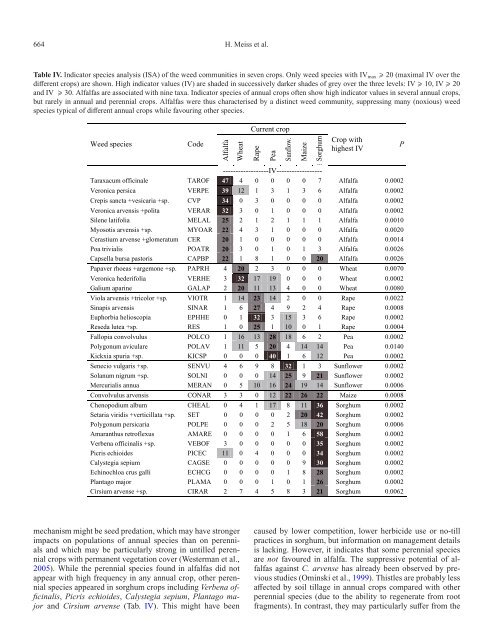Diversifying crop rotations with temporary grasslands - Université de ...
Diversifying crop rotations with temporary grasslands - Université de ...
Diversifying crop rotations with temporary grasslands - Université de ...
Create successful ePaper yourself
Turn your PDF publications into a flip-book with our unique Google optimized e-Paper software.
664 H. Meiss et al.<br />
Table IV. Indicator species analysis (ISA) of the weed communities in seven <strong>crop</strong>s. Only weed species <strong>with</strong> IVmax 20 (maximal IV over the<br />
different <strong>crop</strong>s) are shown. High indicator values (IV) are sha<strong>de</strong>d in successively darker sha<strong>de</strong>s of grey over the three levels: IV 10, IV 20<br />
and IV 30. Alfalfas are associated <strong>with</strong> nine taxa. Indicator species of annual <strong>crop</strong>s often show high indicator values in several annual <strong>crop</strong>s,<br />
but rarely in annual and perennial <strong>crop</strong>s. Alfalfas were thus characterised by a distinct weed community, suppressing many (noxious) weed<br />
species typical of different annual <strong>crop</strong>s while favouring other species.<br />
Weed species Co<strong>de</strong><br />
Alfalfa<br />
Current <strong>crop</strong><br />
Crop <strong>with</strong><br />
highest IV<br />
m<br />
------------------IV------------------<br />
Taraxacum officinale TAROF 47 4 0 0 0 0 7 Alfalfa 0.0002<br />
Veronica persica VERPE 39 12 1 3 1 3 6 Alfalfa 0.0002<br />
Crepis sancta +vesicaria +sp. CVP 34 0 3 0 0 0 0 Alfalfa 0.0002<br />
Veronica arvensis +polita VERAR 32 3 0 1 0 0 0 Alfalfa 0.0002<br />
Silene latifolia MELAL 25 2 1 2 1 1 1 Alfalfa 0.0010<br />
Myosotis arvensis +sp. MYOAR 22 4 3 1 0 0 0 Alfalfa 0.0020<br />
Cerastium arvense +glomeratum CER 20 1 0 0 0 0 0 Alfalfa 0.0014<br />
Poa trivialis POATR 20 3 0 1 0 1 3 Alfalfa 0.0026<br />
Capsella bursa pastoris CAPBP 22 1 8 1 0 0 20 Alfalfa 0.0026<br />
Papaver rhoeas +argemone +sp. PAPRH 4 20 2 3 0 0 0 Wheat 0.0070<br />
Veronica he<strong>de</strong>rifolia VERHE 3 32 17 19 0 0 0 Wheat 0.0002<br />
Galium aparine GALAP 2 20 11 13 4 0 0 Wheat 0.0080<br />
Viola arvensis +tricolor +sp. VIOTR 1 14 23 14 2 0 0 Rape 0.0022<br />
Sinapis arvensis SINAR 1 6 27 4 9 2 4 Rape 0.0008<br />
Euphorbia helioscopia EPHHE 0 1 32 3 15 3 6 Rape 0.0002<br />
Reseda lutea +sp. RES 1 0 25 1 10 0 1 Rape 0.0004<br />
Fallopia convolvulus POLCO 1 16 13 28 18 6 2 Pea 0.0002<br />
Polygonum aviculare POLAV 1 11 5 20 4 14 14 Pea 0.0140<br />
Kickxia spuria +sp. KICSP 0 0 0 40 1 6 12 Pea 0.0002<br />
Senecio vulgaris +sp. SENVU 4 6 9 8 32 1 3 Sunflower 0.0002<br />
Solanum nigrum +sp. SOLNI 0 0 0 14 25 9 21 Sunflower 0.0002<br />
Mercurialis annua MERAN 0 5 10 16 24 19 14 Sunflower 0.0006<br />
Convolvulus arvensis CONAR 3 3 0 12 22 26 22 Maize 0.0008<br />
Chenopodium album CHEAL 0 4 1 17 8 11 36 Sorghum 0.0002<br />
Setaria viridis +verticillata +sp. SET 0 0 0 0 2 20 42 Sorghum 0.0002<br />
Polygonum persicaria POLPE 0 0 0 2 5 18 20 Sorghum 0.0006<br />
Amaranthus retroflexus AMARE 0 0 0 0 1 6 58 Sorghum 0.0002<br />
Verbena officinalis +sp. VEBOF 3 0 0 0 0 0 35 Sorghum 0.0002<br />
Picris echioi<strong>de</strong>s PICEC 11 0 4 0 0 0 34 Sorghum 0.0002<br />
Calystegia sepium CAGSE 0 0 0 0 0 9 30 Sorghum 0.0002<br />
Echinochloa crus galli ECHCG 0 0 0 0 1 8 28 Sorghum 0.0002<br />
Plantago major PLAMA 0 0 0 1 0 1 26 Sorghum 0.0002<br />
Cirsium arvense +sp. CIRAR 2 7 4 5 8 3 21 Sorghum 0.0062<br />
mechanism might be seed predation, which may have stronger<br />
impacts on populations of annual species than on perennials<br />
and which may be particularly strong in untilled perennial<br />
<strong>crop</strong>s <strong>with</strong> permanent vegetation cover (Westerman et al.,<br />
2005). While the perennial species found in alfalfas did not<br />
appear <strong>with</strong> high frequency in any annual <strong>crop</strong>, other perennial<br />
species appeared in sorghum <strong>crop</strong>s including Verbena officinalis,<br />
Picris echioi<strong>de</strong>s, Calystegia sepium, Plantago major<br />
and Cirsium arvense (Tab. IV). This might have been<br />
Wheat<br />
Rape<br />
Pea<br />
Sunflow.<br />
Maize<br />
Sorghum<br />
caused by lower competition, lower herbici<strong>de</strong> use or no-till<br />
practices in sorghum, but information on management <strong>de</strong>tails<br />
is lacking. However, it indicates that some perennial species<br />
are not favoured in alfalfa. The suppressive potential of alfalfas<br />
against C. arvense has already been observed by previous<br />
studies (Ominski et al., 1999). Thistles are probably less<br />
affected by soil tillage in annual <strong>crop</strong>s compared <strong>with</strong> other<br />
perennial species (due to the ability to regenerate from root<br />
fragments). In contrast, they may particularly suffer from the<br />
P

















